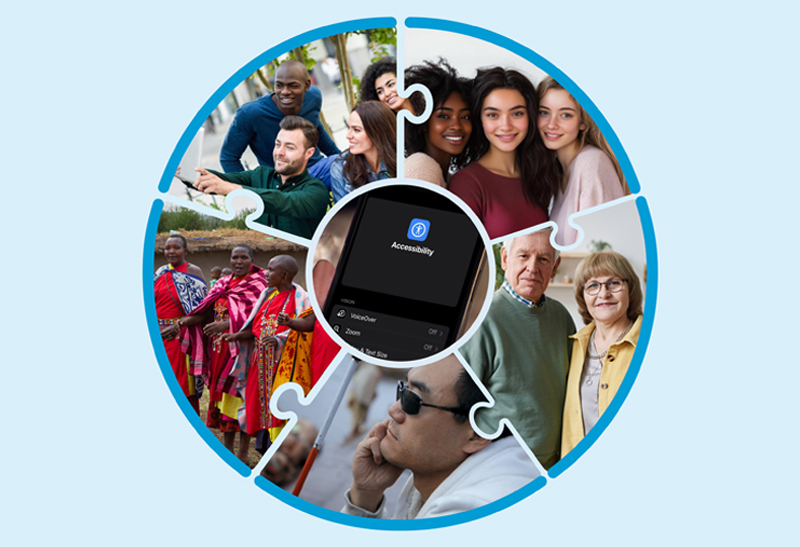Leveraging ICTs and emerging tech, the work of ITU-D ensures everyone, everywhere, can have access to, use of, and benefit from digital products and services
Digital inclusion is a holistic, intersectional approach to promoting ICT and digital accessibility, aiming to build a digitally inclusive world for all—regardless of age, gender, ability, or geographical location.
Digital Inclusion work approach
 Visual Representation of ITU-D's Work Approach to Digital Inclusion:
Visual Representation of ITU-D's Work Approach to Digital Inclusion:
This powerful visual—shaped as a circle to symbolize the interconnectedness of our digital world—captures ITU-D's holistic approach to digital inclusion. It presents five interlinked puzzle pieces, each representing a key group often facing digital barriers: women and girls, older persons, persons with disabilities, people in rural, remote, and Indigenous communities, and young people.
At the heart of the circle is a mobile phone displaying the universal accessibility symbol. This central placement underscores a core principle: digital accessibility must be embedded in all ICT products and services to ensure they are usable and beneficial for everyone—especially the most in need.
More than just a graphic, this visual sends a strong message: ICT accessibility is not a feature—it is a foundation. It reflects ITU-D's firm commitment to placing digital accessibility at the core of its digital inclusion efforts, working to build a digital society and ecosystem where no one is left behind.
Ensuring No One Is Left Behind in the Digital World
At ITU-D, we are committed to advancing a digitally inclusive society where everyone—regardless of age, ability, educational background, socio-economic status, or geographical location—can participate equitably and fully in the digital society and ecosystem. To help realize this vision, we take action through the following key pillars:
Enabling the Development of National Digital Inclusion Policies and Strategies:
We provide expert guidance, technical support, and practical tools and resources to ITU Member States, Sector Members, and Academia to strengthen their capacity to formulate and implement National Digital Inclusion Policies and Strategies. Our goal is to ensure that the design and deployment of ICT products and services comply with ICT accessibility requirements and so, place the inclusion of all people at the heart of national digital agendas.
Building and Sharing Knowledge to Foster More Inclusive Societies and Regions:
Through platforms such as Accessible Regional – ICT for ALL, we create spaces to strengthen knowledge on ICT accessibility while promoting knowledge exchange, peer learning, and collaboration. These platforms facilitate the sharing of good practices and build bridges across regions, contributing to the development of inclusive digital societies, economies, and environments at the local, regional, and global levels.
Empowering All People Equitably through ICTs: Leaving No One Behind:
We work with ITU members and multi-stakeholder partners to design and implement impactful initiatives, projects, and activities that close the digital divide. Our focus is on empowering everyone including those groups in vulnerable situations such as—women and girls, older persons, persons with disabilities, and people from rural, remote, and Indigenous communities—through knowledge and the use of ICTs for their socio-economic advancement, enabling them to become active participants in the digital society and economy.